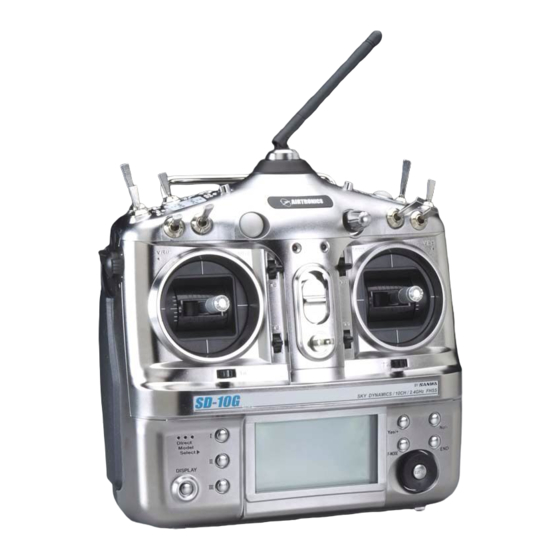AIRTRONICS SD-10G Aero Manual - Página 3
Navegue en línea o descargue pdf Manual para Mando a distancia AIRTRONICS SD-10G Aero. AIRTRONICS SD-10G Aero 16 páginas. 2.4ghz fhss-3 radio control system
También para AIRTRONICS SD-10G Aero: Manual de configuración rápida (8 páginas), Manual de inicio rápido (5 páginas)

glossary of terms
Activate: To turn ON a particular function.
Ailvator: Ailvator mixes ailerons and elevator, allowing you to have both roll control and pitch control on the elevator, separate
from the ailerons. When Activated, not only will the two elevator halves move up and down together, but each elevator half can
move up and down independently like ailerons. This function is commonly referred to as tailerons or stabilators.
Antenna: Transmits the signal from the transmitter to the receiver in the model. The Antenna should be extended and pivoted
into the vertical position during use. When not in use, the Antenna should be retracted and collapsed into the horizontal position
to prevent damage during handling and transport.
Antenna Reception Wires: The portion of each of the receiver antenna wires that actually receives the transmitter signal. The
Antenna Reception Wires should never be bent or they could be damaged and limit the range of the receiver.
Auxiliary Dial Knob: The Auxiliary Dial Knob is programmable and will perform a different function depending on what function
is assigned to it.
Auxiliary Lever: Two Auxiliary Levers are featured, one on each side of the transmitter. Each
Auxiliary Lever is programmable and will perform a different function depending on what function is assigned to it.
Battery Compartment: Houses the 6 cell 1500mAH Ni-MH battery that powers the transmitter. The transmitter uses a 6 cell
battery for lighter weight and better feel, while still providing long usage time.
Battery Fail Safe: The Battery Fail Safe function allows you to set a custom receiver voltage, that when reached, will provide
feedback to you by quickly cycling the throttle servo up and down in 1 minute intervals to indicate that the receiver battery has
reached the programmed Battery Fail Safe voltage. This feedback will help prevent you from flying too long and losing receiver
battery power.
Binding: The act of pairing the transmitter and receiver to prevent interference from radio controllers operated by other users.
The transmitter and receiver must be paired so that the two can 'talk' to each other. Once the Binding process is complete, the
setting is remembered even when the transmitter and receiver are turned OFF.
Camber: Camber is typically used on sailplanes and refers to the function of lowering the entire trailing edge of the wing to
change airfoil of the wing, and therefore, the flight characteristics of your aircraft. Camber is typically used during launch to
maximize lift.
Camber Point: The Camber Point function allows you to define how Auxiliary Lever (VR6) controls Camber. Based on the
Camber Point setting, you can control both Camber and Reflex, or you can control only Camber or Reflex. When programmed to
control only Camber or Reflex, the amount of servo travel will be doubled. This is useful for those pilots who want more overall
travel, but in only one direction.
CCPM: Collective, Cyclic, Pitch Mixing. CCPM is software-controlled mixing that allows control of the collective, cyclic and pitch
using three (and sometimes four) servos. This allows lower mechanical complexity and greater control precision. In this
configuration the cyclic and collective controls are mixed. 3-Point and 4-Point mixes are featured.
CCPM Servo End Point Adjustment: The CCPM End Point Adjustment function allows you to adjust servo travel in each direction
for the elevator, aileron, and pitch servos independently. Unlike standard End Point Adjustment, which affects all the cyclic servos,
CCPM End Point Adjustment allows you to adjust each cyclic servo independently without any affect on the other cyclic servos.
CCPM Servo Linear: The CCPM Servo Linear function converts the rotary output of the servo(s) to a Linear approximation and
helps correct any abnormal cyclic movement caused by off-center control arms when at full positive or negative End Points and
allows you to adjust the overall Rates for the elevator, aileron, and pitch servos independently.
CCPM Servo Delay: The CCPM Servo Delay function allows you to adjust the speed of the elevator, aileron, and pitch servos
independently. Even though the servos may be of the same type, not all servos operate at the same exact speed. If one or more
servos controlling the swashplate is operating faster than another servo, this can cause swashplate geometry issues and even
result in binding of the swashplate linkage assemblies. Slowing down the faster servo(s) to match the slower servo(s) helps to
fine-tune the swashplate, ensuring the most accurate and smoothest movement as possible throughout the entire deflection range.
Channel Delay: The Channel Delay function allows you to adjust the speed of individual servos. This function has several uses.
For example, not all servos operate at the same exact speed. If your model uses separate aileron and flap servos, you may find
that even though the servos are the same, one servo may move faster than the other. You can use the Channel Delay function
to slow down the faster servo to match the slower servo. The Channel Delay function can also be used to slow down a servo
that controls a specific function to achieve a more scale transit time, for example, to open and close a canopy on a scale aircraft.
The Channel Delay function operates independently of the CCPM Servo Delay and CP3 Servo Delay functions in HELI mode.
Channel Offset: The Offset function allows you to shift and hold the neutral position of the desired elevator, aileron, and rudder
servo(s) during flight.
Page 195
